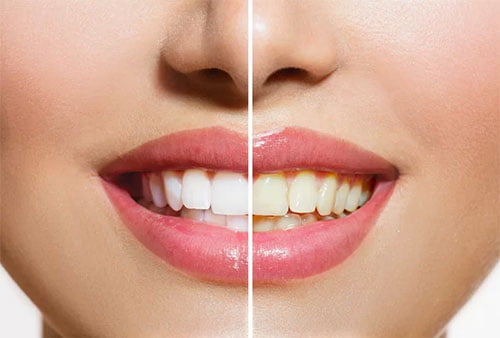Tooth Discoloration
A condition where the tooth loses its natural color or tone is called tooth discoloration. If you ever feel embarrassed and self-conscious about the color of your teeth, don’t worry, you are not alone.
Of the total population, 64% of people are unhappy with their teeth and the main culprit is Tooth Discoloration. The discoloration is a common symptom of a dying tooth that no longer receives a fresh supply of blood.
A discolored or dying tooth appears either yellow, light brown, grey or even black. As the discoloration increases over a period of time, the tooth starts decaying and eventually leads to the death of the nerve attached to it.
Factors like smoking, bad eating habits and stains from coffee, alcohol, etc., are the main causes of developing discoloration.
Types of Tooth Discoloration
Modern dentistry has tremendously progressed over the years and can now fix almost any kind of tooth injury sustained while playing a sport. Tooth and mouth injuries fall into three different categories:
Intrinsic Staining
Generally caused by side-effects of certain medications, intrinsic staining occurs within your tooth’s inner structure, called the dentin.
When the dentin darkens, it starts showing on the surface of your tooth as a yellow or grey tint. Some of the main causes of intrinsic staining include any kind of trauma or injury to the tooth and infection.
Since intrinsic staining affects the internal structure of your tooth, dentists often suggest a cosmetic treatment besides professional whitening.
Extrinsic Staining
This occurs in the enamel, the outer layer of your tooth. The stains can range from white streaks to yellow tints or brown spots.
Extrinsic staining mainly occurs because of eating foods or drinking beverages that have strong colors in them, for example, black tea, berries, red wine etc.
Professional dental cleaning or whitening treatment is enough for getting rid of these stains.
Causes
This is one of the most severe teeth and mouth injuries that usually results in the displacement of the tooth. In this type of injury, the tooth is completely knocked out or it is driven back into the jawbone.
- Food & drinks: Dark-colored drinks such as coffee, tea, wine and vegetables like apples and potatoes contribute to discoloration of the tooth. Chromogens, a chemical present in these items stain the tooth. These food items also contain artificial colors and dyes that are also stain-producing elements.
- Tobacco products: These products contain sticky particles called nicotine that get stuck in the tooth enamel, causing significant staining of the teeth.
- Tooth decay: When you eat foods containing sugar, the bacteria in your mouth start breaking them and produce acids. These acids when not brushed off regularly leads to plaque (tooth decay) that affects the tooth enamel.
- Genetics: Genetics is also an unfortunate factor that results in tooth discoloration. Some people, by nature, have brighter or darker enamel.
- Diseases: In some cases, Chemotherapy causes staining of the teeth. Certain infections during pregnancy also cause this dental disorder.
Prevention
- Brush and floss your teeth properly with a fluoride toothpaste daily
- Stop smoking and consuming tobacco-based products
- Rinse your mouth with a fluoride-based mouthwash after meals
- Regular dental cleaning is must
